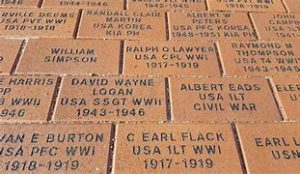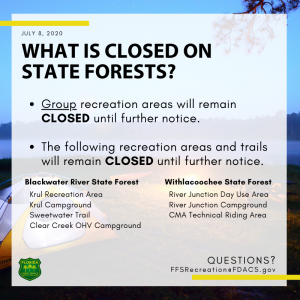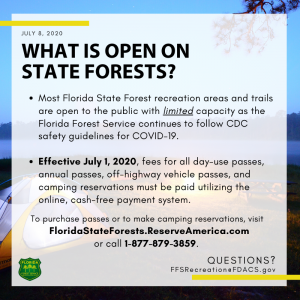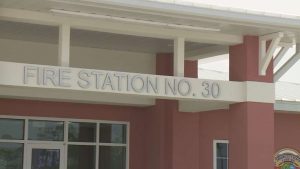Falling Waters State Park is having a Vintage Camper Drive Thru Open House. This Saturday, July 18th 8am to sunset. You will have to pay a park entrance fee of $5 per vehicle. Falling Waters is located at 1130 State Park Road in Chipley.

Falling Waters State Park is having a Vintage Camper Drive Thru Open House. This Saturday, July 18th 8am to sunset. You will have to pay a park entrance fee of $5 per vehicle. Falling Waters is located at 1130 State Park Road in Chipley.

The Republican Party of Jackson County has taken a slight edge over the Democratic Party. Democrats now trail behind the Republican Party by just six registered voters.
Clint Pate, the head of the Jackson County Republican Party said they’re excited about meeting their goal and their current lead over the Democratic Party in the area. He said they had a large gap to fill and being over by six voters is a huge accomplishment for the Republican Party in Jackson County. Pate said the switch began to slowly happen back in 2014 when he and Eric Hill were the first Republican candidates voted into office in Jackson County history. Now, Pate also credits COVID-19 for part of their success as well.
Back in March, the Republican Party sent out over 5,000 flyers and they saw a late increase in registered Republican voters.
Jackson County has a big local election season coming up as well. The Sheriff, Supervisor of Elections, Superintendent and two County Commissioner seats will be up for election and Pate believes the shift from blue to red in the county could affect the results.
For more information on how to get registered to vote or on Jackson County local elections, visit the Supervisor of Election’s https://www.jacksoncountysoe.org/. They have already started sending out vote by mail ballots.
Earlier this month, this blog featured a piece on the Plastic Free July movement. However, working towards eliminating plastic in your life when living in a rural community can seem especially daunting. Below is a short list of changes you can make living here in the Panhandle to reduce the presence of chemically harmful plastic in your life.
1. Swap goods and services with neighbors! Need a new blender but don’t want to buy a plastic wrapped monstrosity from Walmart? Check in with your neighbors to see if anyone has a spare in their storage or are finally ready to admit they just don’t like smoothies and pass their blender on to you. If you’re on Facebook, consider joining or creating a Zero Waste Swap group in your area. Oftentimes people are willing to give up items for FREE! How great is that? You don’t have to pay for something you need, someone else keeps from throwing that something into the waste stream, AND there’s no new waste introduced by your purchasing a new item. Saving plastic all around!
2. Stick to the basics! This includes using shopping totes, fabric produce bags, reusable water bottles and coffee containers, foregoing plastic straws unless you need them medically, packing a lunch instead of a store packaged one, and so on. While simple, these actions add up. Additionally, it is safe to use reusable shopping bags despite COVID-19 – just sanitize between uses. Cloth bags are the best because you can just toss them in your wash.
3. Create the means to be the change! This is related to the step above. If you notice a need in your community, fill it. For example, if you are in need of cloth bags, create them. You can sustainably source material from thrift stores in the form of curtains, sheets, mismatched pillowcases, and more. Then bring them home, sanitize them, and get to sewing! Pass the bags out for free to family and friends or make a small profit by selling them cheap outside grocery stores or farmers’ markets. This is just one example of how you can help reduce your communities reliance on plastic while you’re largely stuck at home during quarantine.
This article was largely sourced from the following blog, please check it out! It has a lot of great additional information and is a very moving piece on rural community: https://www.dailykos.com/stories/2019/4/8/1848735/-Thinking-Outside-the-Plastic-Box-Going-Plastic-Free-in-Rural-America

Don’t forget the Jackson County Elections Candidate Forum is tonight, July 14 at 6 p.m. on the grounds at Citizens Lodge, located at 4574 Lodge Drive in Marianna. Candidates will be allowed to set up a 10-by-10-foot tent along the track area and hand out materials beginning at 5 p.m. until the forum begins at 6 p.m. and after the conclusion of the forum at approximately 8 p.m., until no later than 9 p.m. Check this blog from earlier this week for more details about this being a COVID-19 social distancing event.
Races and candidates are listed below:
State Attorney, Circuit 14: Larry Basford (Rep) and Wes Hatcher (Rep)
Clerk of the Circuit Court and Comptroller: Justin Branch (Rep) and Clayton O. Rooks III (Dem)
Property Appraiser: David Fraser (Rep) and Rebecca Morris-Haid (Dem)
Sheriff: Kevin Arnold (Dem), Hayes Baggett (Dem), Donnie Edenfield (Rep), Scott Edwards (Rep), Tim Ham (Dem), and Jeff Snell (Rep)
Superintendent of Schools: Steve R. Benton, Sr. (Rep), Gerald F. Brockner (Rep), Dallas Ellis (Rep), and Larry Moore (Dem)
Supervisor of Elections: Carol A. Dunaway (Rep), Alice Pate (Rep), Gail Ann Ward (NPA), and Rico Williams (Dem)
Tax Collector: Mary Carol Murdock (Dem), incumbent, unopposed
Jackson County Commissioner — District 1: Alex B. McKinnie (Dem) and Willie E. Spires (Dem)
Jackson County Commissioner — District 3: Paul A. Donofro Jr. (Rep), Marcell Shane Harvey (Dem), Mary Ann Hutton (Rep), Tyler Lipford (Rep), Rance L. Massengill (NPA) and Ronstance L. Pittman (Dem)
Jackson County Commissioner — District 5: John Bryan (Rep), Byron L. Dickens (Dem), and James Peacock (Rep)
Jackson County School Board Member — District 2: Tony Pumphrey (NPA), incumbent, unopposed
Jackson County School Board Member — District 5: Pam Long Bimberg (NPA) and Stacey Goodson (NPA)
Visit the Jackson County elections office website by clicking this link jacksoncountysoe.com or call 850-482-9652 for additional voter information.

Diners have another sit-down dining opportunity in town with the recent transformation of a closed seafood eatery into a grill with an international theme. The new restaurant, Agave Mexican Grill, is owned by Alberto Munoz, who also is co-owner of San Marcos in Marianna.
Munoz owns Agave on his own, taking the plunge after the former Captain’s Table became available. His life partner, Dacia Alcala, manages the eatery. Munoz said he pulled the trigger on the lease just before COVID-19 put all in-restaurant dining on hold. The restaurant is named after the plant used to make tequila. Although the restaurant doesn’t have a formal bar, mixed drinks—including those made with tequila, are available, along with beer and wine. An understated availability of those spirits leaves the restaurant with a kid-friendly presence, and colorful art with Mexican themes provides its international flair.
Contact info: (850) 593-0062 ~ https://www.facebook.com/agavemxgrill/ ~ 8110 US-90 in Sneads ~ Monday: CLOSED ~ Tuesday-Thursday: 10:00 AM – 8:00 PM ~ Friday: 10:00 AM – 9:00 PM ~ Saturday: 11:00 AM – 9:00 PM ~ Sunday: 11:00 AM – 8:00 PM

Last month, the Florida Forest Service announced that group recreation areas located on State Forests would reopen on July 10 with a limited capacity of 50 people. Due to the exponential increase in COVID-19 cases, group recreation areas and select other areas will remain CLOSED until further notice. All reservations through August 31, 2020 will be fully refunded. No new reservations will be accepted until further notice.
Visit FDACS.gov/FLStateForests to learn more about Florida’s State Forests.


Elections are coming up and the Jackson County Chamber of Commerce has announced a Jackson County Elections Candidate Forum that will be held on July 14 at 6 p.m. on the grounds at Citizens Lodge which is located at 4574 Lodge Drive in Marianna. The event’s outdoor venue was chosen because it allows for more attendance and proper social distancing. Those attending are asked to follow all recommended CDC guidelines. Portable toilets and extra hand-washing stations will be on site for the convenience and safety of the public.
Candidates will be allowed to set up a tent along the track area and hand out materials from 5 to 6 p.m. and after the forum until no later than 9 p.m. The forum is expected to conclude at about 8 p.m. Candidates will speak in alphabetical order, by last name. Representatives will be allowed to speak in place of a candidate and will speak in order of the candidate’s last name. Each candidate will be allowed three minutes to speak, and the firm time limit will be enforced, Chamber officials said. “This event is open to the public and is being held to provide citizens the opportunity to be educated about the issues and candidates in a nonpartisan and open format,” the Chamber release stated. “Food vendors will be available beginning at 5 p.m. Local FFA Chapters will be giving away boiled peanuts. For questions or further information please contact Tiffany Garling at the Jackson County Chamber of Commerce via phone 850-482-8060 or email tiffany@jacksoncounty.com.
Register to vote! For the Aug. 18 Primary, the deadline for new voter registrations or party changes is July 20th. You can register or make changes to your registration online at https://registertovoteflorida.gov/home . Early Primary voting is scheduled for 8 a.m. to 5 p.m. Aug. 3-15, and 9 a.m. to 5 p.m. Sunday, Aug 9, at three locations:
• Supervisor of Elections Office, 2851 Jefferson St., Marianna
• Graceville City Hall, 5348 Cliff St., Graceville
• Sneads Town Hall, 2028 Third Ave., Sneads
Visit the Jackson County elections office website, jacksoncountysoe.com or call 850-482-9652 for additional voter information.
The Panama City Beach Fire Rescue officially moved in a new fire station the last of June. Fire and city officials celebrated Fire Station NO. 30 becoming operational. The new station will house seven firefighters daily, so now a total of 17 firefighters will be on duty across the three stations each day. The new station is located right in the center of the city off of North Nautilus Road. According to Fire Chief Larry Couch, this will help cut response time almost in half. The new facility is filled with new green features such as automatic lights and efficient air conditioning.
The contractor was approved at Thursday morning’s City Council meeting in January 2019. After giving the okay to more than a five million dollar budget for the project, approving the contractor was the final step into getting the new station built.

Some of Florida’s newest laws officially went into effect on July 1st. After several months of fighting a pandemic, this year’s legislative session feels like it wrapped up forever ago. Quick recap — lawmakers filed about 3,500 bills. They passed 191 of those. Here’s a few of them that took effect on the 1st~
HB 641 – TEACHER PAY
State sets aside $400 million to raise the minimum base pay for full-time classroom teachers to at least $47,500. Another $100 million will be used to raise the salaries of Florida’s veteran teachers and other instructional personnel who did not receive a salary increase or who received an increase of less than two percent.
CS/CS/SB 404 – PARENTAL CONSENT
Girls under 18 will need a parent’s consent before having an abortion. Previous law only required minors to inform a parent or legal guardian of their decision.
HB 43 – JORDAN’S LAW
The bill is designed to protect children from abuse in the state’s welfare system by reducing the workload for caseworkers; meaning the maximum caseload would be no more than 15 children, if possible. The bill also requires caseworkers to receive training developed on the recognition of and response to head trauma and brain injury in children under six years old. Additionally, caseworkers and law enforcement would share data collected more optimally to help children stay away from violent caregivers.
CS/CS/HB 971 – ELECTRIC BIKES The bill creates regulations governing the operation of e-bikes in the state of Florida, allowing them on streets, highways, roadways, shoulders, bicycle lanes, and bicycle or multi-use paths. Local governments still maintain authority to limit their use.
HB 7067 – SCHOOL CHOICE
The bill expands access to the Family Empowerment Scholarship (FES) Program, the Florida Tax Credit (FTC) Scholarship Program, and the Hope Scholarship Program (HSP) which provide financial assistance to families seeking private education. Bill also establishes a dual enrollment funding incentive for school districts.
SB 1084 – EMOTIONAL SUPPORT ANIMALS
The legislation aims to crack down on the abuse of emotional support animal certifications. It allows housing providers to prohibit use in situations where the animal poses a direct threat to the safety, health, or property of others. Property owners can also request written proof of the support animal’s certification from federal, state, and local government agencies or specified health care providers.
SB 172 – FLORIDA DRUG AND COSMETIC ACT
Legislation preempting local government’s ability to ban the sale of over-the-counter proprietary drugs and cosmetics, which include sunscreen. The law comes after Key West limited the sale of certain types of sunscreen fearing it was destroying coral reefs in the area.
CS/HB 327 – ILLEGAL TAKING, POSSESSION AND SALE OF BEARS
Penalties increase for taking or possessing a freshly killed bear during the closed season. Those in violation face a first-degree misdemeanor for the first offense and forfeit any other Fish and Wildlife Conservation Commission (FWC) license or permit for three years. A subsequent offense leads to permanent ineligibility of any future FWC license or permit. A person who possesses for sale or sells an illegally-taken bear commits a third-degree felony.
SB 400 – ELDER ABUSE FATALITY REVIEW TEAMS
Creates teams in each of the state’s judicial districts to review closed cases of elder fatalities caused by abuse or neglect. After reviews, teams will make policy recommendations to help prevent future abuse-related fatalities.
CS/HB 177 – DRUG REPOSITORY PROGRAM
Creates a drug donation repository and distribution program for unused medication in the state. Bill changes current law requiring the destruction of many drugs despite being unopened and safe for use.
CS/HB 659 – DRONES
Fish and Wildlife Conservation Commission or Florida Forest Service can use drones to manage or eradicate invasive exotic plants or animals on public lands. Also to suppress or mitigate wildfire threats.
SB 1082 – DOMESTIC VIOLENCE INJUNCTIONS
Authorizes that courts can include pets in temporary restraining orders for survivors of domestic violence.